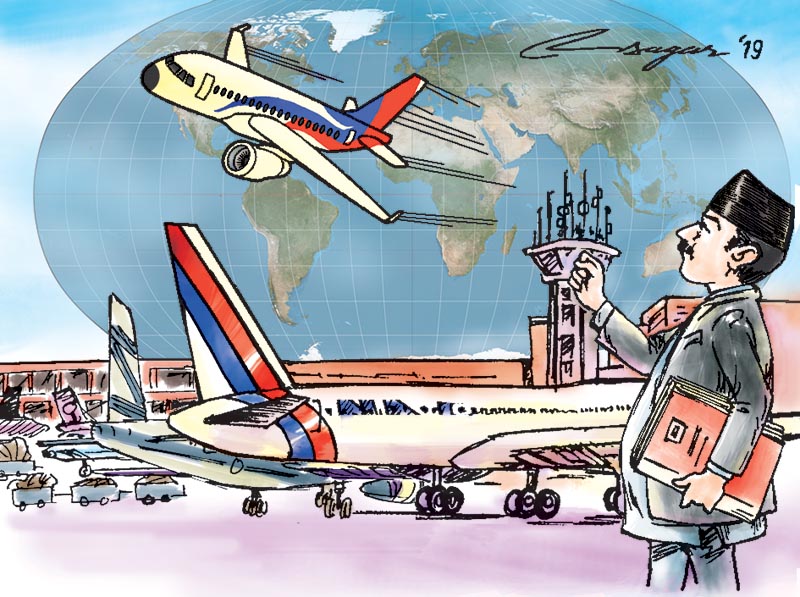Airlines, travel and tourism: Enhance visitor export
Policy-makers must come out from the ‘balance-sheet-focussed’ perception of NAC. When national flag carriers all over the world are being helped by respective governments, the only option for the government is to follow the trend
The first commercial flight by a passenger jet started on October 26, 1958 from New York to Paris. With four jet engines, Boeing’s 707 cut the transatlantic time to seven hours with a load of 120 passengers. It was the beginning of the ‘jet-age miracle’ with ‘jet-setter’ travellers, which made the planet earth, “if not small, then certainly accessible”. Within ten years of the introduction of jet aircraft, American tourists to Europe increased from 500,000 in 1958 to 2 million in 1968. The golden years of jet airlines dominated the world of travel and tourism for almost four decades. Air transport service is considered a glamorous business, almost like the glamour in cinema.
Nepal Airlines Corporation (NAC) also joined the jet age by acquiring Boeing jets. In the late eighties, NAC acquired two highly advanced B757 jets, which made it possible to take NAC’s reach all the way to London, Paris, Frankfurt and Osaka. After a gap of 22 years, NAC tried to purchase two wide-body and four narrow-body aircraft in the year 2009.
As the then prevailing procurement law did not allow direct purchases in any public sector entity, NAC had to go for global bidding, which resulted in the entry of Airbus jets in the fleet.
Until the late seventies, International Air Transport Association (IATA) controlled the air fares, and airlines could afford to entertain passengers with five-star meals with Scotch, wine, champagne and what not. Those golden years of airlines started declining after deregulation was decreed by U.S. President Carter in 1978. Another jolt came to the airlines when the Low Cost Carrier (LCC) was launched in Europe in 1995 and in Asia in 2001. Many airlines, including national flag carriers of many countries, have suffered losses. Many governments saved their flag carriers by injecting billions of dollars.
Surely, Nepal Airlines Corporation (NAC) cannot be an exception. In fact, NAC had to face ‘double trouble’. In addition to the tough competition, NAC just did not expand its fleet for more than two decades, leaving the lucrative international sector to foreign competitors.
The only silver lining of this fiasco in NAC was the increased volume of ground-handling business due to the entry of more and more foreign airlines at the Tribhuvan International Airport. Policy-makers and decision-makers in high places just did not bother to analyse what went wrong with the national flag carrier, which was once considered the best airline in South Asia.
Of course, competition can only be tackled by more efficient management and cost-saving measures. Moreover, statistics will easily prove that NAC’s performance in key indicators, like occupancy, punctuality and reliability is at par with many foreign airlines coming to Kathmandu. But the problem of zero growth in seat production capacity for more than two decades is the main reason for the so-called non-performance of the national flag carrier.
This zero growth in seat production of NAC resulted in the ‘monopoly’ of foreign airlines to charge exorbitant air fares for travel to Nepal. As per experts, airfare is the topmost factor in deciding a vacation destination.
It is high time our policy-makers and top bureaucrats realised that the “only dollar-earning sustainable industry viable in Nepal is the tourism industry” in the words of one Western diplomat. It must be emphasised here that without enhanced capacity of the national flag carrier to bring in more international tourists, high growth rate in foreign tourist arrivals is just not possible.
The policy-makers must come out from the ‘balance-sheet-focussed’ perception of NAC. When dozens of national flag carriers all over the world are being helped by respective governments by injecting billions of dollars, the only option for the government is to follow the world trend. It will not be right to criticise NAC’s workforce without analysing the ground reality in the world of airlines business.
Moreover, it is just not rational to expect over-night profit from an investment of US$ 220 million for two wide-body aircraft with more than 10 per cent interest, probably one of the highest interest rates for the acquisition of aircraft in the whole world.
It is essential that travel and tourism stalwarts start using a relatively new terminology of ‘visitor export’, which is defined as money spent by foreign visitors in a country. The revenue earned by visitor export is considered a key component of the direct contribution of the travel and tourism sector.
As per the annual analysis carried out by the World Travel & Tourism Council (WTTC), the world generated US$ 1,643.2 billion in visitor exports in the year 2018, and this is expected to grow by 4 per cent with 1,484,910,000 international tourist arrivals in 2019.
According to one World Bank report, tourism is a key sector of comparative advantage for Nepal. With every six tourist arrivals to Nepal, one new job is created, whereas world average is one new job with every 11 tourist arrivals.
So long as Nepal remains one of the most expensive air destinations in the world, substantial growth in foreign tourist arrivals is just not possible. Hence, the national flag carrier NAC must spread its wings as fast as possible by any means to make air fare to Nepal as cheap as that for other destinations in this part of the world.
Kansakar is managing director, NAC






